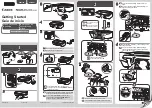
Double-Sided Printing
Printing can be done on regular copier-type paper or on pre-printed
forms using either manual or cassette feed. Normally, you only print
on one side of a page; however, you are not limited to just one-sided
printing.
Double-sided printing is possible using manual feed. Print the first
side using manual feed.
To print on the back side, simply turn the sheet over and insert it
back into the printer. The most frequent problem with double-sided
printing is jamming. If you experience this, give the printer and the
sheet a short breathing time to cool down before reinserting. Check
to see if the paper is curled. If the paper curls after the first pass,
uncurl it before inserting it back into the printer.
Overlay Printing
Overlay printing is possible using manual feed. Print one side using
one sheet in the standard tray. You may use either regular or manual
feed since there is only one sheet of paper in the tray.
To overlay the first printing with a second printing (on the same
side), simply insert the paper back into the standard tray image-side
down, top edge first, and print the file. This causes the second image
to “overlay” on top of the first image.
Labels, Transparencies, and Envelopes
You can print transparencies for overhead projectors, sheets of
self-adhesive labels, and envelopes of almost any size using the
standard tray. All these special materials require using the face-up
collating tray.
Chapter 2
P r i n t e r U s e
2 - 1 1
Summary of Contents for PS 410
Page 1: ...QMS PS 410 User s Guide 1800148 001E...
Page 8: ...v i...
Page 14: ......
Page 16: ......
Page 24: ......
Page 26: ......
Page 46: ......
Page 62: ......
Page 82: ......
Page 84: ......
Page 102: ......
Page 114: ......
Page 116: ......
Page 138: ......
Page 140: ......
Page 154: ......
Page 156: ......
Page 170: ......
Page 204: ......
Page 206: ......
Page 222: ......
Page 224: ......
Page 232: ......
Page 240: ......
Page 241: ...Appendix C Optional Accessories Available QMS Accessories C 1...
Page 242: ......
Page 245: ...Appendix D Character Encoding Tables Character Encoding Tables D 1...
Page 246: ......
Page 249: ...Appendix D Symbol Encoding Character Encoding Tables D 3...
Page 252: ......
Page 256: ......
Page 258: ......
Page 280: ......
















































